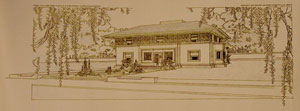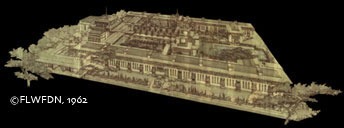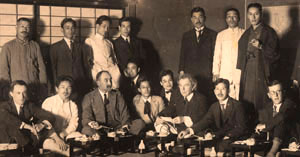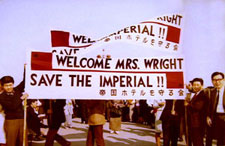Frank Lloyd Wright’s fascination with Japan began with ukiyo-e woodblock prints in the late 1880s and spanned his entire lifetime. When the 37-year-old architect made his very first trip outside America, in 1905, it was not to Europe — that mecca of Western architecture — but to Japan. With his wife Catherine and another couple, he spent two months touring natural and historical landmarks from Nikko all the way down to Takamatsu. Wright was able to maintain his idealized image of Old Japan throughout the visit, despite the country’s wholesale rush to modernize, calling it “the most romantic, most beautiful” nation on earth.
 Wright always credited Japan’s arts, and not its architecture, with inspiring his work. But while in the Japanese countryside, he could not have helped absorbing the vernacular of the temples, shrines and homes: the hip-gabled roofs; the gigantic overhanging eaves; the endless tatami mats; the fusuma and shoji panels used to reshape rooms; the union of interior and exterior spaces. In these traditional structures, he found confirmation of the organic design principles he had been developing for a decade.
Wright always credited Japan’s arts, and not its architecture, with inspiring his work. But while in the Japanese countryside, he could not have helped absorbing the vernacular of the temples, shrines and homes: the hip-gabled roofs; the gigantic overhanging eaves; the endless tatami mats; the fusuma and shoji panels used to reshape rooms; the union of interior and exterior spaces. In these traditional structures, he found confirmation of the organic design principles he had been developing for a decade.
The Wrights returned home as Japanophiles. Within a year, Wright mounted his first ukiyo-e show at the Art Institute of Chicago. For the next two decades, much of his income would be from the thousands of prints that passed through his hands.
 Prompted by Frederick Gookin, a friend and fellow Japanese print dealer, Wright began a vigorous pursuit of the contract to build Tokyo’s new Imperial Hotel in late 1911. The first golden age of his career had recently drawn to a close with several years of personal upheavals; when his mistress was brutally murdered in 1914, Japan seemed an even more alluring refuge from the public condemnation at home. Finally, after years of project delays and several trans-Pacific crossings, Wright took up temporary residence in Tokyo in January 1917.
Prompted by Frederick Gookin, a friend and fellow Japanese print dealer, Wright began a vigorous pursuit of the contract to build Tokyo’s new Imperial Hotel in late 1911. The first golden age of his career had recently drawn to a close with several years of personal upheavals; when his mistress was brutally murdered in 1914, Japan seemed an even more alluring refuge from the public condemnation at home. Finally, after years of project delays and several trans-Pacific crossings, Wright took up temporary residence in Tokyo in January 1917.
 Over the six tumultuous years he lived off and on in Tokyo, Wright poured his prodigious creativity into the Imperial Hotel project. It would remain, as the many decades of his career passed, his largest and most complex design. He also designed at least a dozen other buildings for Japan, including an embassy, a school, a hotel and a temporary hotel annex, a theater, a commercial-residential complex and seven residences. Of these, six were built: the Imperial Hotel and Annex, the Jiyu Gakuen School, the Aisaku Hayashi House, the Arinobu Fukuhara House and the Tazaemon Yamamura House. Only the school and Yamamura House survive, along with portions of the Imperial and Hayashi House.
Over the six tumultuous years he lived off and on in Tokyo, Wright poured his prodigious creativity into the Imperial Hotel project. It would remain, as the many decades of his career passed, his largest and most complex design. He also designed at least a dozen other buildings for Japan, including an embassy, a school, a hotel and a temporary hotel annex, a theater, a commercial-residential complex and seven residences. Of these, six were built: the Imperial Hotel and Annex, the Jiyu Gakuen School, the Aisaku Hayashi House, the Arinobu Fukuhara House and the Tazaemon Yamamura House. Only the school and Yamamura House survive, along with portions of the Imperial and Hayashi House.
 But Wright left another, equally significant, legacy in Japan: his transformative effect on the men who helped him build the Imperial Hotel. Many of them went on to create their own masterpieces, to alter Japan’s cityscapes and mentor a new generation of pioneering architects. Among these were his righthand man, Arata Endo, the first architect to share credit with the master; Antonin Raymond, the Czech-born “violent evolutionary” who led Japan’s modernist movement during his 43 years in the country; Kameki and Nobu Tsuchiura, who followed Wright to Los Angeles and stayed with him for two years; Yoshiya Tanoue, Takehiko Okami, Eizo Sugawara, Muraji Shimomoto, Taro Amano and their professional progeny.
But Wright left another, equally significant, legacy in Japan: his transformative effect on the men who helped him build the Imperial Hotel. Many of them went on to create their own masterpieces, to alter Japan’s cityscapes and mentor a new generation of pioneering architects. Among these were his righthand man, Arata Endo, the first architect to share credit with the master; Antonin Raymond, the Czech-born “violent evolutionary” who led Japan’s modernist movement during his 43 years in the country; Kameki and Nobu Tsuchiura, who followed Wright to Los Angeles and stayed with him for two years; Yoshiya Tanoue, Takehiko Okami, Eizo Sugawara, Muraji Shimomoto, Taro Amano and their professional progeny.
 Japan is the only nation outside of America in which Wright lived and worked, but his imprint there has been endangered by the loss of those with firsthand knowledge, and the casual destruction of historic buildings, documents and artifacts. In 2005, marking the centenary of Wright’s first visit to Japan in 1905, the nonprofit Wrightian Architectural Archives Japan was founded to ensure that his legacy of innovative, organic design would live on.
Japan is the only nation outside of America in which Wright lived and worked, but his imprint there has been endangered by the loss of those with firsthand knowledge, and the casual destruction of historic buildings, documents and artifacts. In 2005, marking the centenary of Wright’s first visit to Japan in 1905, the nonprofit Wrightian Architectural Archives Japan was founded to ensure that his legacy of innovative, organic design would live on.
 Wright always credited Japan’s arts, and not its architecture, with inspiring his work. But while in the Japanese countryside, he could not have helped absorbing the vernacular of the temples, shrines and homes: the hip-gabled roofs; the gigantic overhanging eaves; the endless tatami mats; the fusuma and shoji panels used to reshape rooms; the union of interior and exterior spaces. In these traditional structures, he found confirmation of the organic design principles he had been developing for a decade.
Wright always credited Japan’s arts, and not its architecture, with inspiring his work. But while in the Japanese countryside, he could not have helped absorbing the vernacular of the temples, shrines and homes: the hip-gabled roofs; the gigantic overhanging eaves; the endless tatami mats; the fusuma and shoji panels used to reshape rooms; the union of interior and exterior spaces. In these traditional structures, he found confirmation of the organic design principles he had been developing for a decade.The Wrights returned home as Japanophiles. Within a year, Wright mounted his first ukiyo-e show at the Art Institute of Chicago. For the next two decades, much of his income would be from the thousands of prints that passed through his hands.
 Prompted by Frederick Gookin, a friend and fellow Japanese print dealer, Wright began a vigorous pursuit of the contract to build Tokyo’s new Imperial Hotel in late 1911. The first golden age of his career had recently drawn to a close with several years of personal upheavals; when his mistress was brutally murdered in 1914, Japan seemed an even more alluring refuge from the public condemnation at home. Finally, after years of project delays and several trans-Pacific crossings, Wright took up temporary residence in Tokyo in January 1917.
Prompted by Frederick Gookin, a friend and fellow Japanese print dealer, Wright began a vigorous pursuit of the contract to build Tokyo’s new Imperial Hotel in late 1911. The first golden age of his career had recently drawn to a close with several years of personal upheavals; when his mistress was brutally murdered in 1914, Japan seemed an even more alluring refuge from the public condemnation at home. Finally, after years of project delays and several trans-Pacific crossings, Wright took up temporary residence in Tokyo in January 1917.  Over the six tumultuous years he lived off and on in Tokyo, Wright poured his prodigious creativity into the Imperial Hotel project. It would remain, as the many decades of his career passed, his largest and most complex design. He also designed at least a dozen other buildings for Japan, including an embassy, a school, a hotel and a temporary hotel annex, a theater, a commercial-residential complex and seven residences. Of these, six were built: the Imperial Hotel and Annex, the Jiyu Gakuen School, the Aisaku Hayashi House, the Arinobu Fukuhara House and the Tazaemon Yamamura House. Only the school and Yamamura House survive, along with portions of the Imperial and Hayashi House.
Over the six tumultuous years he lived off and on in Tokyo, Wright poured his prodigious creativity into the Imperial Hotel project. It would remain, as the many decades of his career passed, his largest and most complex design. He also designed at least a dozen other buildings for Japan, including an embassy, a school, a hotel and a temporary hotel annex, a theater, a commercial-residential complex and seven residences. Of these, six were built: the Imperial Hotel and Annex, the Jiyu Gakuen School, the Aisaku Hayashi House, the Arinobu Fukuhara House and the Tazaemon Yamamura House. Only the school and Yamamura House survive, along with portions of the Imperial and Hayashi House. But Wright left another, equally significant, legacy in Japan: his transformative effect on the men who helped him build the Imperial Hotel. Many of them went on to create their own masterpieces, to alter Japan’s cityscapes and mentor a new generation of pioneering architects. Among these were his righthand man, Arata Endo, the first architect to share credit with the master; Antonin Raymond, the Czech-born “violent evolutionary” who led Japan’s modernist movement during his 43 years in the country; Kameki and Nobu Tsuchiura, who followed Wright to Los Angeles and stayed with him for two years; Yoshiya Tanoue, Takehiko Okami, Eizo Sugawara, Muraji Shimomoto, Taro Amano and their professional progeny.
But Wright left another, equally significant, legacy in Japan: his transformative effect on the men who helped him build the Imperial Hotel. Many of them went on to create their own masterpieces, to alter Japan’s cityscapes and mentor a new generation of pioneering architects. Among these were his righthand man, Arata Endo, the first architect to share credit with the master; Antonin Raymond, the Czech-born “violent evolutionary” who led Japan’s modernist movement during his 43 years in the country; Kameki and Nobu Tsuchiura, who followed Wright to Los Angeles and stayed with him for two years; Yoshiya Tanoue, Takehiko Okami, Eizo Sugawara, Muraji Shimomoto, Taro Amano and their professional progeny. Japan is the only nation outside of America in which Wright lived and worked, but his imprint there has been endangered by the loss of those with firsthand knowledge, and the casual destruction of historic buildings, documents and artifacts. In 2005, marking the centenary of Wright’s first visit to Japan in 1905, the nonprofit Wrightian Architectural Archives Japan was founded to ensure that his legacy of innovative, organic design would live on.
Japan is the only nation outside of America in which Wright lived and worked, but his imprint there has been endangered by the loss of those with firsthand knowledge, and the casual destruction of historic buildings, documents and artifacts. In 2005, marking the centenary of Wright’s first visit to Japan in 1905, the nonprofit Wrightian Architectural Archives Japan was founded to ensure that his legacy of innovative, organic design would live on.
